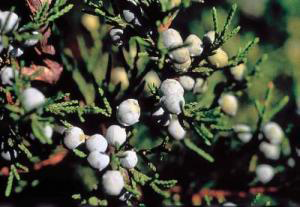Juniperus virginiana provides food and shelter for many species of birds and mammals, including winter food for pheasant, mule deer, and whitetail deer.
Photo Credit: © USDA-NRCS PLANTS Database/Herman, D.E., et al. 1996. North Dakota tree handbook. USDA NRCS ND State Soil Conservation Committee; NDSU Extension and Western Area Power Administration, Bismarck.
Juniperus virginiana
Common Name: eastern redcedar
Plant Functional Group: Evergreen conifer
Class > Order > Family: Pinopsida > Pinales > Cupressaceae
What does the species look like?
Eastern redcedar is an evergreen, conifer shrub to tree growing 30 to 70 feet tall. Male and female cones occur on separate trees. The small male cones bear pollen, and the slightly larger female cones become berry-like in maturity. This species is wind-pollinated.
Eastern redcedar occurs on a wide range of soils and in many growing conditions, from swamps to dry, rocky glades. It can tolerate soils ranging from acid sands to those derived from limestone.
Where is the species found?
States & Provinces
AL, AR, CO, CT, DC, DE, FL, GA, IA, IL, IN, KS, KY, LA, MA, MD, ME, MI, MN, MO, MS, NC, ND, NE, NH, NJ, NY, OH, OK, ON, OR, PA, QC, RI, SC, SD, TN, TX, VA, VT, WI, WV
Which phenophases should I observe?
Do you see...?
Pollen cones
Pollen cones More...
How many fresh pollen cones are present?
Less than 3 3 to 10 11 to 100 101 to 1,000 1,001 to 10,000 More than 10,000
Open pollen cones What percentage of all fresh pollen cones (unopened plus open) on the plant are open?
Less than 5% 5-24% 25-49% 50-74% 75-94% 95% or more
Pollen release More...
How much pollen is released?
Little: Only a few grains are released. Some: Many grains are released. Lots: A layer of pollen covers your palm, or a cloud of pollen can be seen in the air when the wind blows
Seed cones
Unripe seed cones Juniperus virginiana , an unripe seed cone is berry-like and green.More...
How many seed cones are unripe?
Less than 3 3 to 10 11 to 100 101 to 1,000 1,001 to 10,000 More than 10,000
Ripe seed cones Juniperus virginiana , a berry-like seed cone is considered ripe when it has turned dark blue, purple or brownish blue, often covered with a whitish film that rubs off.More...
How many seed cones are ripe?
Less than 3 3 to 10 11 to 100 101 to 1,000 1,001 to 10,000 More than 10,000
Recent cone or seed drop More...
How many seed cones have dropped seeds or have completely dropped or been removed from the plant since your last visit?
Less than 3 3 to 10 11 to 100 101 to 1,000 1,001 to 10,000 More than 10,000
What do these phenophases look like?
There is currently no photoguide available for this species. If you'd like help us create one, use the guidance document and species template provided here . Then send it via email to education@usanpn.org when it is complete.
